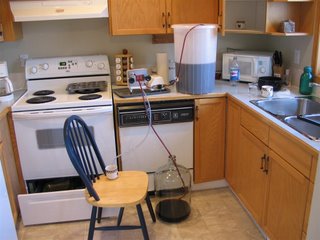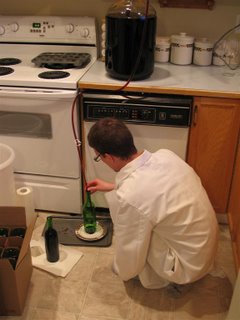Not Abandoned...
Last we heard my red wine was in the secondary fermentor. After about twelve days or so I racked it into the primary fermentor and then back into the secondary fermentor after washing it. Potassium metabisulphite was added to kill off any remaining yeast and other wild microorganisms and also to act as an antioxidant which helps protect the colors and flavours of the wine. The wine was still cloudy at this time because the dead yeast cells are being suspended in the wine by bubbles of carbon dioxide. The wine was vigorously stirred over the next 2 or 3 days to remove this carbon dioxide and then potassium sorbate was added as a fermentation inhibitor. After this a fining agent was added which helps clarify the wine. It works through the use of subtractive magic. The wine was left to clarify for about a week. After a week, I rented a filtration apparatus from the local winemaking supplies store. Although the wine appears to be clear at this point, filtration gives it that final polish. I first racked the wine into my primary fermentor and then filtered it back into the washed seconcdary fermentor. All that's left now it the bottling. Generally, colourless bottles are used for white wine and green bottles are used for red wine. The bottles are sterilized and then filled with wine, leaving about an inch or so of headspace. I used a corker to put the cork in and let the bottles sit for two days right-side-up while the corks expand. After this the label was applied as well as the shrink-wrap foil. The bottles are stored on their sides because the cork needs to stay moist to ensure a proper seal. It is now ready to drink or to age awhile in a cool, dark place.





0 Comments:
Post a Comment
<< Home